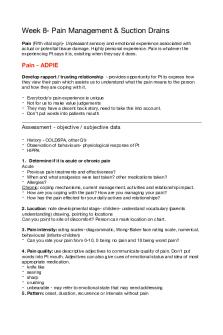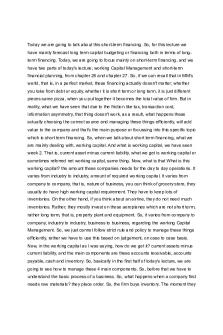Cycle 8 - Lecture notes 16-17 PDF

| Title | Cycle 8 - Lecture notes 16-17 |
|---|---|
| Course | Biology for Science I |
| Institution | The University of Western Ontario |
| Pages | 5 |
| File Size | 241.5 KB |
| File Type | |
| Total Downloads | 31 |
| Total Views | 129 |
Summary
Professor Vera Tai Lecture...
Description
BIOLOGY 1001A Cycle 8 — Speciation Microevolution —> Macroevolution
Changes in allele frequencies in a population over time o New traits may evolve —> speciation o Process of species formation Differences evolving between populations may restrict gene flow Differences continue to accumulate separately from one population to another to the point they are considered two different species
What is a Species? "No one definition (of species) has as yet satisfied all naturalists; yet every naturalist knows vaguely what he means when he speaks of a species." – Charles Darwin, Origin of Species —> 160 years after Origin of Species, still no universal species concept o One accept does not apply to all life o Over 50 species concepts have been proposed Many ways (concepts) to identify and define a species:
Populations that have distinctly different traits Populations that successfully mate with each other, but not with other populations Populations that do not exchange genetic material with other populations Populations that have distinct evolutionary histories
1. Ecological Species Concept
Species = a group of organisms that are adapted to a particular set of resources (niche) in the environment
2. Morphological Species Concept — similar physical characteristics
Species = a distinct cluster of individuals in phenotypic space. No intermediates or overlap with other clusters. Used when differences in measurable traits distinguishes species. Delineate species based on measurable, observable traits Can compare traits with fossils
BIOLOGY 1001A
PROBLEMS with the morphological Species Concept
Phenotypic variability is not consistent for different species Difficult to distinguish species that look very similar Can identify differences, but no information on how these differences evolved
—> populations that cannot interbreed are different species (reproductive barrier) 3. Biological Species Concept
Species = group of interbreeding populations that are reproductively isolated from other groups Matches criteria that are typically used to define a species o A species compromises all individuals that can successfully mate and produce viable, fertile offspring Collection of alleles can potentially be shared with anyone in the species, but not outside the species Gene flow within species, cohesive, share traits o Not with other species.
—> is testable — put individuals from different populations together Do they successfully mate? —> provides a means to explain how species have evolved Investigate heritable traits, behaviour, physiology that lead to reproductive isolation.
PROBLEMS with Biological Species Concept
For asexually reproducing organisms, species boundaries cannot be defined under BSC May not be possible to test whether individuals can successfully reproduce sexually Reproductive behaviour cannot be determined for extinct organisms.
4. Phylogenetic Species Concept
BIOLOGY 1001A
Species = group of populations with a recent evolutionary history o Smallest group of populations that are all more closely related to each other than to anything else Construction of an evolutionary tree o Can use morphological information o Use genetic information = molecular phylogenetics DNA sequences Amino acid sequences
Ideally groups are monophyletic = all descendants from a common ancestor Must decide how much evolutionary change defines a group or species
Advantages of Phylogenetic Species Concept
Can be applied to any/all organisms (if data can be collected) Molecular data not possible from fossils Molecular data is possible from preserved extinct animals o Ex. Mammoths frozen in permafrost, possibly amber
—> species compromise individuals/populations that share a recent evolutionary history = recent common ancestry of morphological traits. DNA sequences, etc. Must decide how much evolutionary change defines a species For sexually reproducing organisms, implies reproductive isolation, but does not prove it —> can determine how traits have evolved to give rise to new species
BIOLOGY 1001A What Information to Compare Between Individuals
Need to use info that matches the true evolution of the organisms o Shared traits reflect common ancestry ex. Traits are homologous Sometimes info is evolutionarily misleading o Homoplasies = evolved due to convergent evolution and NOT common ancestry
—> Homoplasies are evolutionarily misleading Do not share the same ancestry or common ancestor Similar trait, but evolved independently o Convergent evolution
Superficial Similarity: birds and bats both have wings
Look more closely, the structure of the wings and bones is different Feathers. Vs skin supported by finger bones Birds have hollow bones Wings do not share a recent common ancestry Two different paths of evolution that resulted in wings
Misleading tree:
Birds and bats shown to share ancestry because they share wings
Better Tree:
Using more evolutionarily reliable information o Ex. DNA of a conserved gene Wings in birds and bats evolved independently
BIOLOGY 1001A
Comparing Species Concepts
Different Concepts for delineating species can give you different answers o Not clear cut Male frogs have distinctive calls to attract males o Ex. Biological Species Concept DNA sequences were obtained from frogs of each population, and a phylogenetic tree was constructed: easier to decide with multiple sources of information
SUMMARY
Ideally, species are defined with multiple lines of evidence o Ex. Including morphology, behaviour, ecology, physiology, genetics, trees But there is not a universal definition of a species that equally applies to all life o Multiple species concepts o We have different "rules" for different groups of organisms By understanding speciation: o How do traits evolve? o How does diversity evolve? o How will a species evolve or adapt?...
Similar Free PDFs

Cycle 8 - Lecture notes 16-17
- 5 Pages

CELL Cycle - Lecture Notes
- 3 Pages

8 - Lecture notes 8
- 21 Pages

8 - Lecture notes 8
- 21 Pages

The Calvin Cycle Lecture Notes
- 3 Pages

CNO cycle - Lecture notes 1
- 13 Pages

Krebs Cycle - Lecture notes 1
- 4 Pages

Lecture 8- Life Cycle of Stars
- 8 Pages

Bando unico 1617 def 1 - Voto: 8
- 51 Pages

8 Midwifery - Lecture notes 8
- 3 Pages

Taxation 8 - Lecture notes 8
- 2 Pages

Week 8 - Lecture notes 8
- 6 Pages

Dox 8 - Lecture notes 8
- 21 Pages
Popular Institutions
- Tinajero National High School - Annex
- Politeknik Caltex Riau
- Yokohama City University
- SGT University
- University of Al-Qadisiyah
- Divine Word College of Vigan
- Techniek College Rotterdam
- Universidade de Santiago
- Universiti Teknologi MARA Cawangan Johor Kampus Pasir Gudang
- Poltekkes Kemenkes Yogyakarta
- Baguio City National High School
- Colegio san marcos
- preparatoria uno
- Centro de Bachillerato Tecnológico Industrial y de Servicios No. 107
- Dalian Maritime University
- Quang Trung Secondary School
- Colegio Tecnológico en Informática
- Corporación Regional de Educación Superior
- Grupo CEDVA
- Dar Al Uloom University
- Centro de Estudios Preuniversitarios de la Universidad Nacional de Ingeniería
- 上智大学
- Aakash International School, Nuna Majara
- San Felipe Neri Catholic School
- Kang Chiao International School - New Taipei City
- Misamis Occidental National High School
- Institución Educativa Escuela Normal Juan Ladrilleros
- Kolehiyo ng Pantukan
- Batanes State College
- Instituto Continental
- Sekolah Menengah Kejuruan Kesehatan Kaltara (Tarakan)
- Colegio de La Inmaculada Concepcion - Cebu


